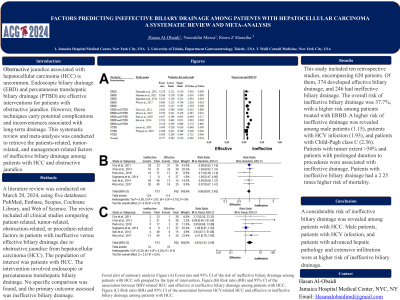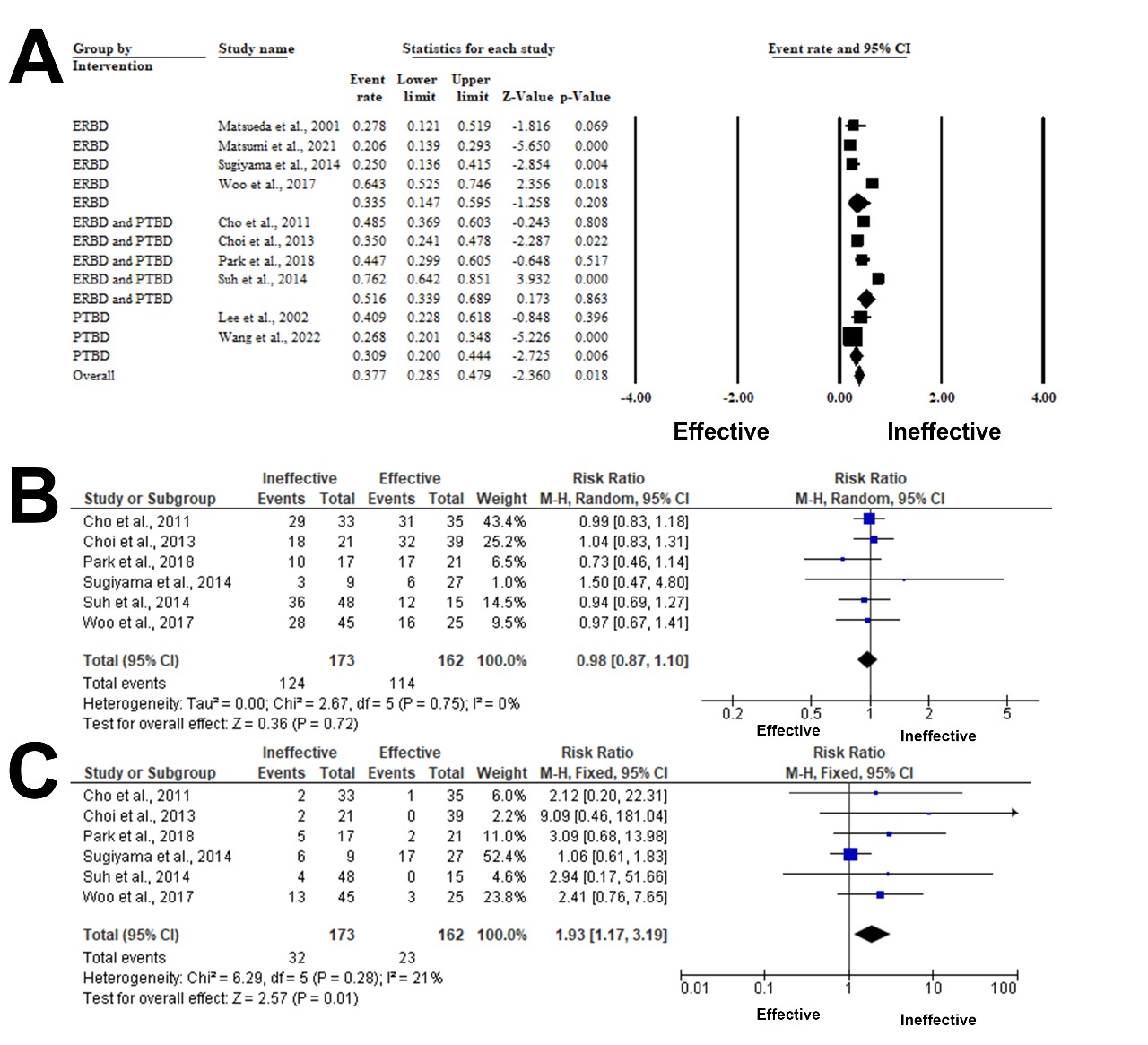Tuesday Poster Session
Category: Biliary/Pancreas
P3459 - Factors Predicting Ineffective Biliary Drainage Among Patients With Hepatocellular Carcinoma: A Systematic Review and Meta-Analysis
Tuesday, October 29, 2024
10:30 AM - 4:00 PM ET
Location: Exhibit Hall E

Has Audio

Hasan Al-Obaidi, MD
Jamaica Hospital Medical Center
Briarwood, NY
Presenting Author(s)
Hasan Al-Obaidi, MD1, Nooraldin Merza, MD2, Reem Sharaiha, MD3
1Jamaica Hospital Medical Center, Briarwood, NY; 2University of Toledo College Medicine and Life Sciences, Toledo, OH; 3Weill Cornell Medicine, New York, NY
Introduction: Obstructive jaundice associated with hepatocellular carcinoma (HCC) is uncommon. Endoscopic biliary drainage (EBD) and percutaneous transhepatic biliary drainage (PTBD) are effective interventions for patients with obstructive jaundice. However, these techniques carry potential complications and inconveniences associated with long-term drainage. This systematic review and meta-analysis was conducted to retrieve the patients-related, tumor-related, and management-related factors of ineffective biliary drainage among patients with HCC and obstructive jaundice.
Methods: A literature review was conducted on March 20, 2024, using five databases: PubMed, Embase, Scopus, Cochrane Library, and Web of Science. The review included all clinical studies comparing patient-related, tumor-related, obstruction-related, or procedure-related factors in patients with ineffective versus effective biliary drainage due to obstructive jaundice from hepatocellular carcinoma (HCC). The population of interest was patients with HCC. The intervention involved endoscopic or percutaneous transhepatic biliary drainage. No specific comparison was found, and the primary outcome assessed was ineffective biliary drainage.
Results: This study included ten retrospective studies, encompassing 620 patients. Of them, 374 developed effective biliary drainage, and 246 had ineffective biliary drainage. The overall risk of ineffective biliary drainage was 37.7%, with a higher risk among patients treated with ERBD. A higher risk of ineffective drainage was revealed among male patients (1.15), patients with HCV infection (1.93), and patients with Child-Pugh class C (2.36). Patients with tumor extent >50% and patients with prolonged duration to procedures were associated with ineffective drainage. Patients with ineffective biliary drainage had a 2.25 times higher risk of mortality.
Discussion: A considerable risk of ineffective biliary drainage was revealed among patients with HCC. Male patients, patients with HCV infection, and patients with advanced hepatic pathology and extensive infiltration were at higher risk of ineffective biliary drainage.

Disclosures:
Hasan Al-Obaidi, MD1, Nooraldin Merza, MD2, Reem Sharaiha, MD3. P3459 - Factors Predicting Ineffective Biliary Drainage Among Patients With Hepatocellular Carcinoma: A Systematic Review and Meta-Analysis, ACG 2024 Annual Scientific Meeting Abstracts. Philadelphia, PA: American College of Gastroenterology.
1Jamaica Hospital Medical Center, Briarwood, NY; 2University of Toledo College Medicine and Life Sciences, Toledo, OH; 3Weill Cornell Medicine, New York, NY
Introduction: Obstructive jaundice associated with hepatocellular carcinoma (HCC) is uncommon. Endoscopic biliary drainage (EBD) and percutaneous transhepatic biliary drainage (PTBD) are effective interventions for patients with obstructive jaundice. However, these techniques carry potential complications and inconveniences associated with long-term drainage. This systematic review and meta-analysis was conducted to retrieve the patients-related, tumor-related, and management-related factors of ineffective biliary drainage among patients with HCC and obstructive jaundice.
Methods: A literature review was conducted on March 20, 2024, using five databases: PubMed, Embase, Scopus, Cochrane Library, and Web of Science. The review included all clinical studies comparing patient-related, tumor-related, obstruction-related, or procedure-related factors in patients with ineffective versus effective biliary drainage due to obstructive jaundice from hepatocellular carcinoma (HCC). The population of interest was patients with HCC. The intervention involved endoscopic or percutaneous transhepatic biliary drainage. No specific comparison was found, and the primary outcome assessed was ineffective biliary drainage.
Results: This study included ten retrospective studies, encompassing 620 patients. Of them, 374 developed effective biliary drainage, and 246 had ineffective biliary drainage. The overall risk of ineffective biliary drainage was 37.7%, with a higher risk among patients treated with ERBD. A higher risk of ineffective drainage was revealed among male patients (1.15), patients with HCV infection (1.93), and patients with Child-Pugh class C (2.36). Patients with tumor extent >50% and patients with prolonged duration to procedures were associated with ineffective drainage. Patients with ineffective biliary drainage had a 2.25 times higher risk of mortality.
Discussion: A considerable risk of ineffective biliary drainage was revealed among patients with HCC. Male patients, patients with HCV infection, and patients with advanced hepatic pathology and extensive infiltration were at higher risk of ineffective biliary drainage.

Figure: Forest plot of summary analysis
Figure (A) Event rate and 95% CI of the risk of ineffective biliary drainage among patients with HCC sub grouped by the type of intervention.
Figure (B) Risk ratio (RR) and 95% CI of the association between HBV-related HCC and effective or ineffective biliary drainage among patients with HCC.
Figure (C) Risk ratio (RR) and 95% CI of the association between HCV-related HCC and effective or ineffective biliary drainage among patients with HCC.
Figure (A) Event rate and 95% CI of the risk of ineffective biliary drainage among patients with HCC sub grouped by the type of intervention.
Figure (B) Risk ratio (RR) and 95% CI of the association between HBV-related HCC and effective or ineffective biliary drainage among patients with HCC.
Figure (C) Risk ratio (RR) and 95% CI of the association between HCV-related HCC and effective or ineffective biliary drainage among patients with HCC.
Disclosures:
Hasan Al-Obaidi indicated no relevant financial relationships.
Nooraldin Merza indicated no relevant financial relationships.
Reem Sharaiha: Boston Scientific – Consultant, Grant/Research Support. Olympus – Consultant. Surgical Intuitive – Advisory Committee/Board Member.
Hasan Al-Obaidi, MD1, Nooraldin Merza, MD2, Reem Sharaiha, MD3. P3459 - Factors Predicting Ineffective Biliary Drainage Among Patients With Hepatocellular Carcinoma: A Systematic Review and Meta-Analysis, ACG 2024 Annual Scientific Meeting Abstracts. Philadelphia, PA: American College of Gastroenterology.
